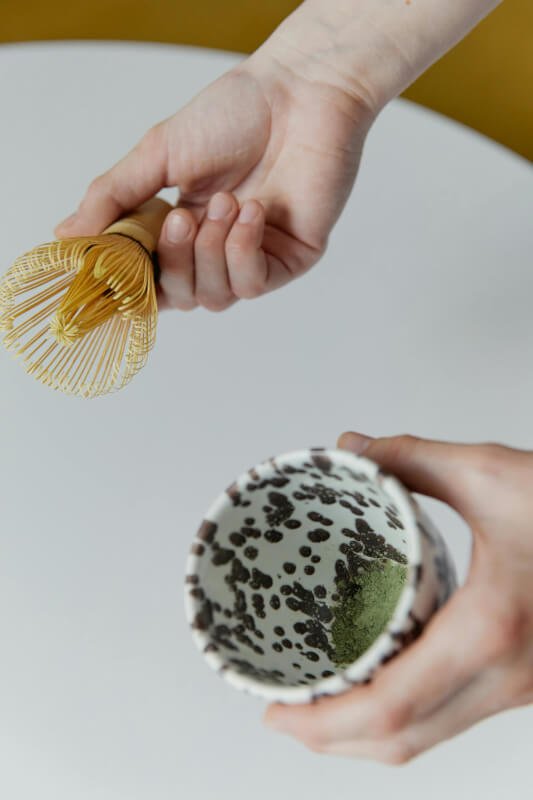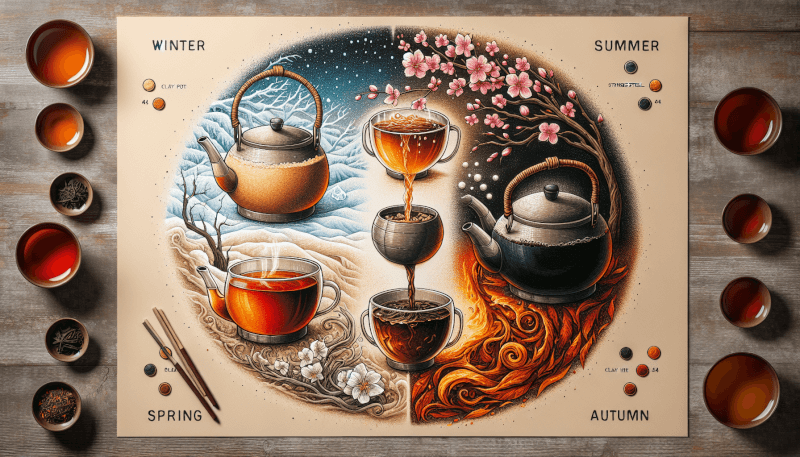For tea lovers, the joy of brewing the perfect cup can be a delightful experience that transcends time and seasons. Whether it’s the cozy warmth of a cup of tea during the winter, or the refreshing iced tea on a hot summer day, the art of brewing tea is one that can be adapted to suit every season. In this article, you will discover some valuable tips and techniques to enhance your tea-brewing skills, allowing you to savor the perfect cup of tea all year round. So grab your teapot and get ready to embark on a journey of flavors that will leave you refreshed and uplifted in any season.

Spring
Choosing tea for spring
When choosing tea for spring, you want to opt for light and fresh options that perfectly complement the rejuvenating spirit of the season. Floral and green teas are excellent choices that capture the essence of springtime. Consider teas like jasmine green tea, which combines the delicate floral aroma of jasmine with the refreshing taste of green tea. White teas and oolongs are also great options, as they offer a subtle and elegant flavor profile that is perfect for the season. Just make sure to avoid heavily roasted teas, as they may overpower the light and delicate flavors that are characteristic of spring.
Brewing temperature in spring
To make the most out of your spring teas, it is important to pay attention to the brewing temperature. Generally, water between 170°F and 180°F is recommended for most spring teas. This temperature range allows you to extract the delicate flavors without scorching the leaves. However, it’s important to adjust the temperature based on the specific tea type. Green teas, for example, typically require lower temperatures, around 160°F to 170°F, to prevent bitterness. On the other hand, white teas can withstand slightly higher temperatures, ranging from 180°F to 190°F. Remember to avoid boiling water for delicate teas, as it can destroy the nuanced flavors and aromas.
Steeping time in spring
Finding the perfect steeping time is crucial to ensure a balanced flavor in your spring teas. It is always a good idea to follow the recommended steeping times provided by the tea manufacturer. For most spring teas, a steeping time of 2-3 minutes is sufficient to extract the desired flavors. However, if you’re brewing delicate teas such as white teas or green teas, it’s best to shorten the steeping time to around 1-2 minutes. This prevents over-extraction, which can result in a bitter taste. Remember that steeping time can also be adjusted based on personal preference, so feel free to experiment and find the perfect strength for your cup of tea.
Flavorings for spring teas
Spring teas can be enhanced with various flavors to add an extra touch of freshness and excitement. Citrus flavors, such as lemon, lime, or orange, can impart a zesty and invigorating twist to your cup of tea. Infusing floral essences like lavender or rose can also elevate the floral notes in your tea, creating a truly fragrant experience. If you prefer a touch of sweetness, try adding a hint of honey or agave syrup to your spring teas. These natural sweeteners can balance out any bitterness and enhance the overall flavor profile of your tea. Play around with different flavor combinations to discover your own signature spring tea blend.
Recommended spring tea recipes
To fully enjoy the delightful flavors of spring, here are some recommended tea recipes:
Jasmine green tea with lemon twist: Brew a cup of jasmine green tea and add a twist of freshly squeezed lemon juice. The floral aroma of jasmine pairs harmoniously with the bright and tangy flavor of lemon, creating a refreshing and uplifting tea beverage.
Chamomile and lavender white tea: Steep a blend of chamomile tea and white tea, then infuse it with a touch of lavender essence. This recipe combines the calming and soothing properties of chamomile with the gentle floral notes of lavender, making it the perfect tea to relax and unwind during the spring season.
Hibiscus iced tea with orange slices: Brew hibiscus tea and let it cool before pouring it over ice. Add a few slices of fresh orange to infuse the tea with a bright and citrusy flavor. This iced tea is not only visually appealing with its vibrant red color but also invigorating and refreshing, making it an ideal choice for those warm spring days.

Winter
Choosing tea for winter
During the winter season, you’ll want to choose teas that bring warmth and comfort to your cup. Opt for teas with bold and robust flavors that can stand up well to the colder temperatures. Black teas, such as Earl Grey or English Breakfast, are classic choices that offer a rich and satisfying taste. Spiced teas, like chai or masala, add an extra layer of warmth with their blend of aromatic spices. For a cozy and soothing experience, try herbal teas like chamomile or peppermint, which can provide a sense of relaxation during the winter months.
Brewing temperature in winter
Getting the brewing temperature right is essential for extracting the full flavor potential of your winter teas. For black teas, boiling water at 212°F is the recommended temperature. This high temperature helps to fully release the flavors and aromas of the tea leaves. However, if you’re brewing more delicate teas like green or white teas, it’s best to use slightly lower temperatures. Aim for around 160°F to 180°F for green teas and 180°F to 190°F for white teas. These temperatures prevent scorching the leaves while still allowing the flavors to develop fully.
Steeping time in winter
Steeping time plays a crucial role in determining the strength and flavor intensity of your winter teas. As a general guideline, black teas should be steeped for around 3-5 minutes to achieve optimal results. This allows enough time for the robust flavors to infuse fully. However, if you prefer a stronger brew, you can increase the steeping time by a minute or two. Green teas, on the other hand, require a shorter steeping time of 2-3 minutes to maintain their delicate flavors. Similarly, white teas should be steeped for approximately 2-3 minutes. These shorter steeping times for delicate teas prevent bitterness and ensure a well-balanced cup.
Flavorings for winter teas
Winter teas can be enhanced with various flavorings to add an extra touch of warmth and indulgence. For black teas, consider adding a dash of milk or cream to create a comforting and creamy texture. You can also spice up your winter teas with cinnamon, nutmeg, or cloves to bring a cozy winter aroma to your cup. For herbal teas, try adding a teaspoon of honey or a splash of vanilla extract for a natural sweetener that perfectly complements the soothing qualities of the tea. These flavorings can elevate your winter tea experience and make it even more enjoyable on those chilly days.
Recommended winter tea recipes
To savor the flavors of winter, here are a few recommended tea recipes:
Peppermint hot chocolate tea: Brew a strong cup of peppermint tea and mix it with your favorite hot chocolate mix. The refreshing minty flavor of peppermint combined with the rich and chocolatey taste of hot chocolate creates a delightful winter treat that will warm you from the inside out.
Spiced apple and black tea blend: Steep a black tea of your choice and add in freshly sliced apples and a sprinkle of cinnamon. This recipe infuses the comforting taste of apples and the aromatic spice of cinnamon into your tea, evoking the cozy ambiance of winter evenings.
Gingerbread chai latte: Prepare a chai tea concentrate by steeping chai tea bags in hot water. While still hot, mix in gingerbread syrup and frothed milk. This indulgent and fragrant drink combines the classic flavors of chai tea with the warmth and sweetness of gingerbread, creating a comforting and festive beverage perfect for winter enjoyment.
With these tips and recipes tailored to each season, you can make the most of your tea brewing experience throughout the year. Whether you’re embracing the freshness of spring, enjoying the summer heat, savoring the autumn colors, or seeking warmth in the winter months, there’s a perfect tea and brewing method to suit every season. So grab your favorite tea leaves, brew a cup, and let the flavors transport you to a world of sensory delight. Cheers to a year-round love affair with tea!



